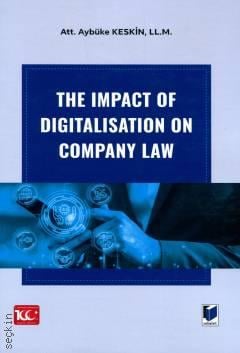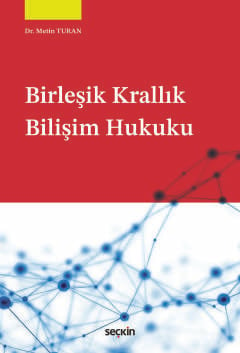
The Impact Of Digitalisation On Company Law
1. Baskı,
Ocak 2024
Kitabın Detayları
Dili:
İngilizce
Ebat:
16x24
Sayfa Sayısı:
206
Kitabın Fiyatı:
385,00₺
Temin süresi 2-3 gündür.
Kitabın Açıklaması
Digitalisation has affected company law as well as many areas in re-cent years. Artifıcial intelligence and blockchain technologies are leading in this regard. Whereas artifıcial intelligence manifests itself in issues such as management and auditing, blockchain technology is located in many processes from the formation of the company to its termination. This the-sis examines artificial intelligence as a board member and an assistant in decision-making processes and emphasises its role in appointing board members. it also scrutinises the impact of artificial intelligence on external audits. in addition, it analyses blockchain technology regarding issues such as the formation of the company, keeping the documents, conducting meetings, and dissolution via blockchain. Blockchain technology, vvhich is used with smart contracts, paves the way for forming decentralised autonomous organisations.
This thesis also examines the effects of digitali¬sation on corporate governance, with reference to corporate governance principles. Moreover, ituates how shareholder rights, minority share-holder rights, and current issues such as board diversity will be amelio-rated in the future. Although there will be no majör change in the short term, it can be claimed that digitalisation will eventually mark an era in company law and corporate governance. More studies on these issues and their legalisation activities are expected to increase in the follovving peri-ods.
Kitabın Konu Başlıkları
Introduction
Artificial Intelligence
Blockchain
Digitalisation and Corporate Governance
Conclusion
Kitapla İlgili Kategoriler
Yorumlar
Kitabın İçindekileri
CONTENTS
GENİŞ ÖZET
7
ABSTRACT
15
ACKNOWLEDGEMENTS
17
CONTENTS
19
ABBREVIATIONS
23
1. INTRODUCTION
25
1.1. Literature Review
25
1.2. Aim and Scope
31
1.3. Problems and Key Research Questions
31
1.4. Overview and Contribution
32
1.5. The Importance of Study
32
1.6. The Planned Structure of the Research
32
1.7. Research Methodology
33
2. ARTIFICIAL INTELLIGENCE
35
2.1. In General
35
2.2. Definitions and Functions of AI
35
2.3. Types of AI
37
2.4. Regulations on AI
38
2.5. Changes Brought by AI
40
2.5.1. In General
40
2.5.2. Effects of AI on Company Law
41
2.6. The Use of AI in the Management of the Company
45
2.6.1. AI as a Director
45
2.6.2. AI–Assisted Decision–Making
49
2.6.3. AI in the Appointment of Board Members
51
2.7. AI and External Audit
54
2.7.1. Audit
54
2.7.2. External Audit
55
2.7.3. Effects of AI on External Audit
56
2.7.4. Possible Uses of AI in External Audit
57
2.7.4.1. In General
57
2.7.4.2. AI as a Decision Aid
60
2.7.4.3. AI as an Auditor
63
2.7.5. Thoughts on the Future of External Audit
67
3. BLOCKCHAIN
71
3.1. In General
71
3.2. Definitions of Blockchain
72
3.3. Types of Blockchain
73
3.4. Characteristics of Blockchain
74
3.5. Smart Contracts
76
3.5.1. In General
76
3.5.2. Smart Contracts on Blockchain
77
3.6. Benefits and Challenges of Blockchain
79
3.7. From Traditional Ways to Blockchain in Companies
82
3.8. Decentralised Autonomous Organisations
85
3.9. Blockchain from the Formation to the Termination of the Company
87
3.9.1. Forming a Company on Blockchain
87
3.9.1.1. Company Formation
87
3.9.1.2. Company Formation via Blockchain
88
3.9.1.3. A Case Study from Estonia
90
3.9.2. Preparation of the Articles of Association on Blockchain
92
3.9.3. Keeping Commercial Books and Records of the Company via
Blockchain
94
3.9.4. Having Annual General Meetings via Blockchain
98
3.9.4.1. Virtual AGMs
98
3.9.4.2. Virtual AGMs via Blockchain
101
3.9.4.3. Drawbacks of Blockchain–based AGMs
104
3.9.5. Having Board Meetings via Blockchain
106
3.9.5.1. Virtual Board Meetings
106
3.9.5.2. Board Meetings and Blockchain
109
3.9.5.3. Drawbacks of Virtual Meetings and the Blockchain
Solution
110
3.9.6. Terminating the Company via Blockchain
111
4. DIGITALISATION AND CORPORATE GOVERNANCE
115
4.1. Corporate Governance
115
4.1.1. In General
115
4.1.2. Digital Corporate Governance
118
4.2. The Principles of Corporate Governance within the Context of New
Technologies
120
4.2.1. Transparency
120
4.2.2. Fairness
125
4.2.3. Accountability
126
4.2.3.1. In General
126
4.2.3.2. Using AI
127
4.2.3.2.1. Effects of AI on Accountability
127
4.2.3.2.2. Liability of AI
129
4.2.3.2.3. The EU Directive
130
4.2.3.2.4. Thoughts on Liability of AI
130
4.2.3.3. Utilising Blockchain
132
4.2.3.4. Regarding DAOs
133
4.2.4. Responsibility
134
4.2.5. Monitoring
137
4.3. Shareholder Rights
140
4.4. Minority Shareholders’ Rights
145
4.5. Compliance
150
4.6. Board Diversity as a Current Corporate Governance Discussion
155
5. CONCLUSION
163
5.1. Significance and Contribution
163
1.2. Future of Research
166
REFERENCES
169
Hakkımızda
|
Uluslararası Yayınevi Belgesi|
Kaynakça Dosyası|
Kişisel Verilerin Korunması |
Üyelik|
Siparişlerim|
İade Politikası|
İletişim


